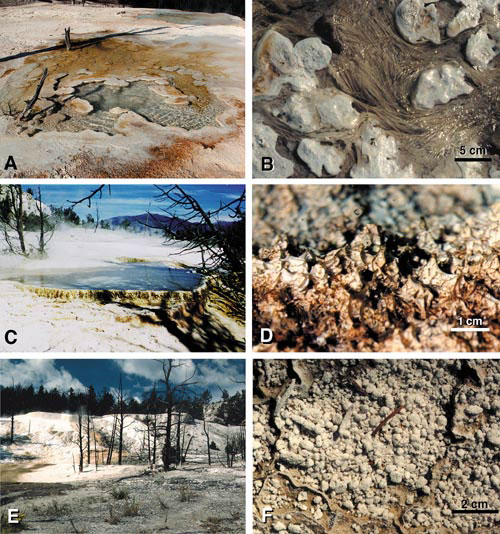

Figure 3. Microbial mats and microenvironments found at Angel Terrace. A. Sulfide vent that formed on south end of Angel Terrace in 1993. Vent temperature was ~73 °C and pH ~6.4. Orange colors along edges of vent are cyanobacterial communities living on and within drying sinter. B. Dominant mat-forming microorganism covering vent walls and channel floors is filamentous form that is genetically related to Aquifex (Anna Louise Reysenbach, 1999, personal commun.). Aquifex forms streamers in channels that become oriented by the flow. Bacterial streamers are eventually encrusted by aragonite, preserving original flow directions in sinter fabric. C. Large mid-temperature pond formed on Angel Terrace in 1996. Near upstream end of pond, temperature was ~65 °C (pH ~7). Floor of pool was covered by cm-scale aragonite shrubs (not shown). At temperatures up to and including 73 °C, thin biofilms of unicellular cyanobacteria (Synechococcus) covered surfaces of shrubs, tinting them yellow-orange. At downstream edge of pond, pool temperature was ~45 °C (pH ~8) and floor was covered by centimeter-thick coniform cyanobacterial mats (Fig. 3D). D. Coniform photosynthetic mats dominated by cyanobacterial taxa, including Spirulina, Phormidium, Synechococcus, and several unidentified oscillatoriceans. Also present is Chloroflexus, an anoxygenic photosynthesizer. Basic mat structure consists of cone-shaped peaks and networks of ridges formed by phototactic (light-induced) gliding of cyanobacteria. Some cones have bulbous enlargements at their tops where mat had entrapped gases (primarily photosynthetic oxygen). Tufted mat structure is faithfully replicated in microtexture of associated sinters. E. Distal slope environment at base of Angel Terrace, Mammoth Hot Springs, Yellowstone National Park, Wyoming (view looking west) (Fouke et al, 2000). Persistent thermal activity had killed most of the trees in this area. F. View of floor of shallow (<cm deep) terracette pond covered by spherulites of calcite. typically form nucleation carbonate on organic material and continue to accrete as they are transported (rolled) downslope